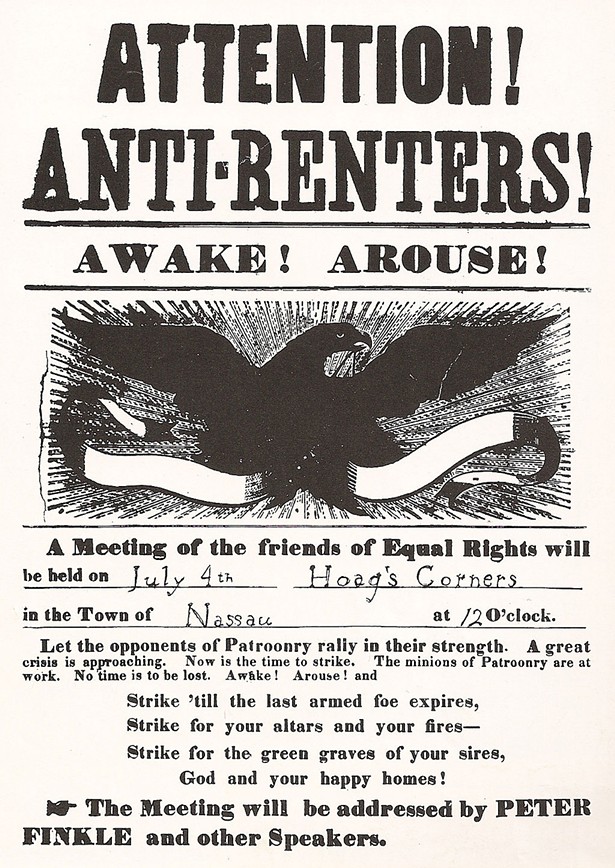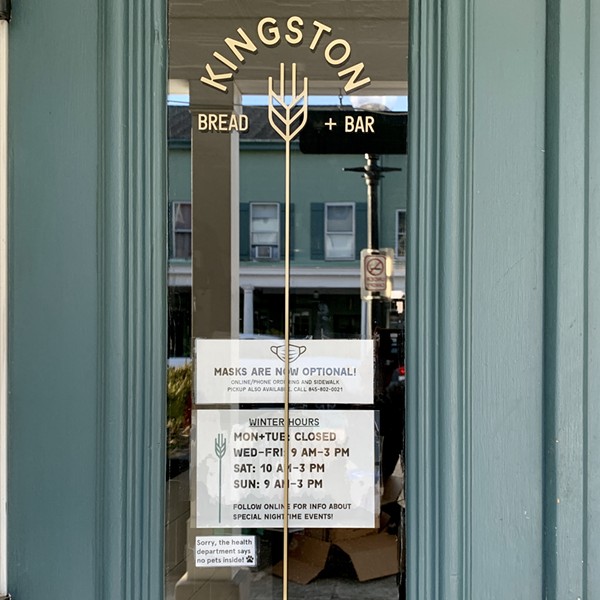Editor’s note: For the first time in nearly three months, the coronavirus pandemic is not the biggest story in America. We’ve watched in anger and sadness as protests erupted across the country this weekend, from Minneapolis to Los Angeles, New York City to New Paltz. We’re strategizing ways to meet this moment; to bring a local lens to the issue of endemic racism and inequality in America. In the meantime, we hope you enjoy this feature. We’ll be back with the next coronavirus news roundup on Monday, June 1. —Phillip Pantuso
Some said the police shot first. Some said it was the protestors. Some said if they’d just followed orders, no one would have died. Some said if there had never been a rebellion, nothing would have changed.
It’s been 175 years since Undersheriff Osman Steele was shot and killed on Moses Earle’s farm in Andes, and in some ways, not much has changed in America in all that time. But one old relic of the Anti-Rent Wars of 19th-century rural New York is slated to pass away soon: New York State’s law outlawing masks, which the state Legislature voted on Wednesday to repeal.
“Every person, who, having his face painted, discolored, covered, or concealed, or being otherwise disguised, in a manner calculated to prevent him from being identified, shall appear in any road or public highway, or in any field lot, wood or enclosure, may be pursued and arrested,” the law begins. Since it was passed in January of 1845, at the height of a furor of anti-landlord organizing in the hills of the Catskills and Hudson Valley, the law has been wielded against Guy Fawkes-masked Occupy protestors and cross-dressers, and survived legal challenges by Pussy Riot and the Ku Klux Klan.
In 1845, the protestors New York State feared most were farmers in leather masks and cotton smocks, who wielded tin horns used for calling the household in to dinner as a summons to fellow protestors in the surrounding hills. The farmers were tenants, under a feudal system that deeded vast tracts of land to wealthy absentee landlords, and the rents they owed frequently outstripped the capacity of their rocky, forbidding lands to produce. Sometimes the landlords sent their lawyers to collect, with law enforcement in tow, and seized property if the tenants could not pay. As anti-rent sentiment spread and the farmers became more organized, bands of tenant farmers known as “Calico Indians” would show up to these property auctions armed and illegally disguised from head to toe, and sometimes tar and feather the “up-renters” who took the landlords’ side.
Undersheriff Osman Steele was a notorious figure in Delaware County, with a penchant for taunting the anti-renters and a local reputation akin to that of the Sheriff of Nottingham. When Steele rode up to Moses Earle’s farm in Andes on August 7, 1845, intent on enforcing the auction of Earle’s livestock over failure to pay $64 in back rent, he was met by a band of hundreds of down-renters who meant to disrupt the sale. Such tactics had previously resulted in the cancelation of similar auctions without bloodshed, but this time was different: Shots were fired, Steele’s horse was shot dead under him, and Steele himself was shot in the gut. He was taken into Earle’s house, and died in excruciating pain some hours later. Some witnesses at the chaotic scene said Steele fired first into the crowd, a claim that remains among the unverifiable narratives of protest history, as murky then as they still are today.
Most of the leather masks that were outlawed by the 1845 law have long since been destroyed—burned or buried by the down-renters, who disbanded in fear for their lives after the deadly skirmish at Moses Earle’s farm. Some historians have said that after the death of Osman Steele, they quickly became objects of shame to their possessors. A young John Burroughs once found one while digging stone with his brothers in a Catskills field.
A few remain. The Hubbell family in Margaretville still has a full costume in their possession, with calico dress, tin horn, and the notorious mask. Local writer Jennifer Kabat describes watching her friend Rudd Hubbell don the unnerving object:
With its crude holes, he looked like he had come out of a horror film. I could just make out his lips and teeth, but his eyes were sunk in darkness. Eyebrows were roughly sewn on in leather. Stitch marks crossed the face. The nose pointed like a beak, as if he was dressed as a hybrid bird-man-monster. Reading glasses dangled around his neck, and they made his whole appearance more disturbing. The glasses, this quotidian symbol of middle age, held him in one world, and the mask made him part of another. Rope was threaded through the bottom of the hood to tighten it at the throat. That way, he said, no one could yank it off and expose you.
In the years that followed Steele’s death, the anti-renters prevailed; their sympathizers formed a potent political force in the state and in the nascent Republican party, the feudal system that held sway over rural New York was broken up, and the two protestors at Earle’s farm who had been sentenced to death were pardoned.
In nearby Andes, a little Delaware County tourist town that’s home to about 1,200 when the summer people are away, the pain and terror of history has long since faded to the vague pang of nostalgia. The paraphernalia of the Anti-Rent Wars has been repurposed as tourist kitsch. A store on Main Street is called The Tin Horn; it sells antiques, soaps, and penny candy. There’s a colorful painted sign at the edge of town to alert visitors coming up Route 28 that they’re entering “The Epicenter Of The Anti-Rent War,” featuring a “Calico Indian” blowing a horn in silhouette. Another sign at the far side of town bears Undersheriff Osman Steele’s infamous tavern taunt: “Lead Can’t Penetrate Steele.” Local folk singers perform down-renter songs for history-themed festivities.
Other echoes still resound. There is a tradition in the police force of naming K9s after fallen officers: Delaware County’s first K9, a German shepherd with an education in narcotics detection who joined the force in 2013, was named Osman “Ozzie” Steele. Ozzie died on April 24, according to the Delaware County Sheriff’s Office, of underlying health conditions.
Nowadays, Delaware County residents with names like “Scudder” and “Sanford,” which crop up often in the old Anti-Rent War histories, tend to be more proud than abashed of their rebellious heritage. But on the floor of the New York State Senate on Wednesday, the old terror of protest reared its head. Opposing the repeal of the anti-mask law, Republican state senator Robert Ortt referred to the Anti-Rent Wars as “land riots.” Twenty-six other state senators joined Ortt in voting against the repeal of the 1845 law, including Jim Seward, who represents part of Delaware County in the 51st District, and who has lately been recuperating from being hospitalized and on a ventilator with COVID-19.
Within days of the state senate vote, the nation was again caught up in terror and bloodshed, as in city after city, police met protestors angered by George Floyd’s death at the hands of the Minneapolis Police Department with brutal force. Disguise and identity have become flashpoints in all aspects of the conflict: Police officers have covered their badges and refused to identify themselves. Protest sympathizers are pleading with photographers on social media not to post photos that could be used to identify protestors, fearing assassinations. Confusion and debate swirl around the identities and affiliations of people setting fires and destroying property: Are they left-wing protestors seeking street justice, white supremacist “Boogaloo” adherents looking to start the next civil war, unprincipled rioters enjoying mayhem and chaos, undercover police infiltrators looking to discredit the protests, or perhaps all of the above? Over all the conflict, the specter of state surveillance made vastly more powerful by facial recognition tools looms large.
The repeal of the old Anti-Rent anti-mask law is now headed to Governor Andrew Cuomo’s desk for signature. As New York State prepares to do away with one law that has long outlawed disguises, it may soon take aim at another one that has long enabled them: 50-a, the law that keeps the records of police accused of misconduct hidden from the public eye. Cuomo said on Saturday that if a reform of 50-a made it to his desk, he’d sign it.
We’ll see.
Lissa Harris is a staff writer for The River. She was the founding editor of the Watershed Post, a site that covered local news in the rural Catskills from 2010 to 2017. Follow her on Twitter @lissaharris.



















